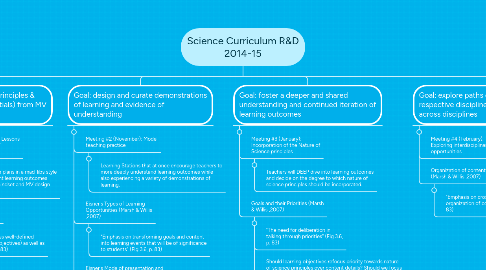
1. Goal: foster a deeper and shared understanding and continued iteration of learning outcomes
1.1. Meeting #3 (January): Incorporation of the Nature of Science principles
1.1.1. Teachers will DEEP dive into learning outcomes and decide on the degree to which nature of science principles should be incorporated.
1.2. Goals and their Priorities (Marsh & Willis ,2007)
1.2.1. "The need for deliberation in talking through priorities" (Fig 3.6, p. 83)
1.2.2. Should learning objectives refocus priority towards nature of science principles over content details? Should we focus on how to DO science over things to KNOW about science?
2. Goal: explore paths of implementation within respective discipline and make connections across disciplines
2.1. Meeting #4 (February): Exploring interdisciplinary opportunities
2.2. Organization of content areas (Marsh & Willis ,2007)
2.2.1. "Emphasis on cross-curricula organization of content." (Fig 2.6, p. 83)
3. Goal: utilize the Design Principles & Practice (Learning Essentials) from MV Continuum
3.1. Meeting #1 (October): Crafting Lessons using Design Principles and MV mindsets
3.1.1. Teachers will craft lesson plans in a mad-libs style that incorporated content learning outcomes along with aligned MV mindset and MV design principle
3.2. Eisner's Goals and their Priorities (Marsh & Willis ,2007)
3.2.1. "The need to consider less well-defined objectives (expressive objectives) as well as explicit ones" (Fig 3.6, p. 83)
4. Goal: design and curate demonstrations of learning and evidence of understanding
4.1. Meeting #2 (November): Model teaching practice
4.1.1. Learning Stations that at once encourage teachers to more deeply understand learning outcomes while also experiencing a variety of demonstrations of learning.
4.2. Eisner's Types of Learning Opportunities (Marsh & Willis ,2007)
4.2.1. "Emphasis on transforming goals and content into learning events that will be of significance to students" (Fig 3.6, p. 83)
4.3. Eisner's Mode of presentation and mode of response (Marsh & Willis ,2007)
4.3.1. "Use of a number of modes of communication to widen educational opportunities for students." (Fig 3.6, p. 83)

